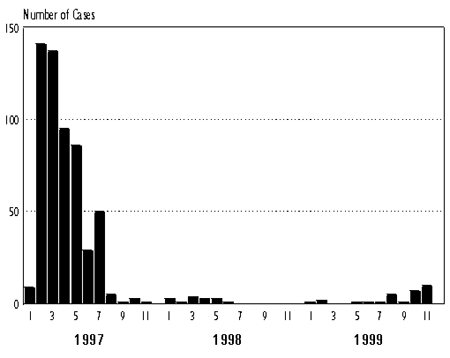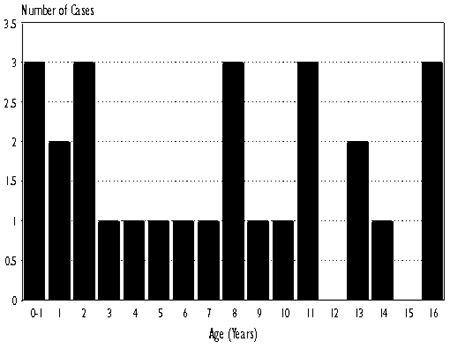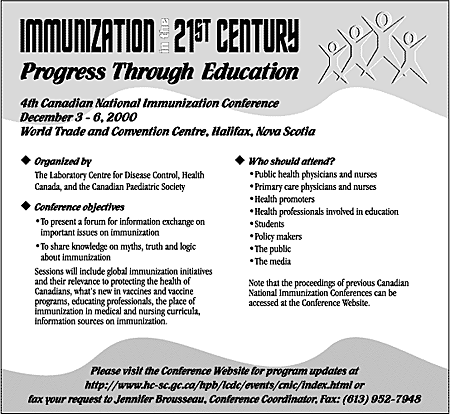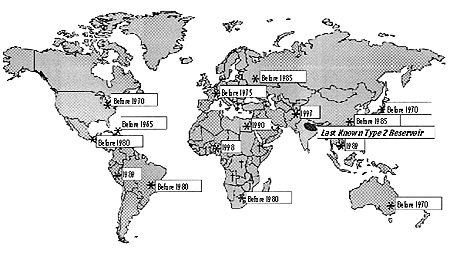Common menu bar links
Institutional links
Diseases & Conditions
Health & Safety
Research & Statistics
Agency Information
Search Box
E-mail this page
Update: Vaccine-Preventable Diseases – A New Direction
Volume 7, Number 3, December 1999/January 2000
As many of our readers know, the Update: Vaccine-Preventable Diseases (VPDU) was started in November 1993 as the Measles Update in response to recommendations from the national Consensus Conference on Measles held in December 1992. The specific recommendations were as follows: “A measles newsletter should be introduced to share otherwise unpublished information among those directly involved with the elimination of the disease”, and “Visual material to assist in the identification of cases, e.g., appearance of rash, should be developed and distributed”. We feel proud that through the Measles Update, the Division of Immunization, Bureau of Infectious Disease, Laboratory Centre for Disease Control, Health Canada, was able to address these needs for information-sharing among federal, provincial/territorial and other health care partners across Canada. This was most evident during the recent years of increased measles activity in parts of the country from 1995 to 1997. In October 1997, the Division of Immunization, in consultation with various partners at the federal, provincial and territorial levels, decided to expand the newsletter to include material on other vaccine-preventable diseases (VPDs) and its title was changed to Update: Vaccine-Preventable Diseases to reflect the new focus.
The feedback received over the years has been reassuring in confirming that the expanded newsletter continued to serve a useful function for sharing information on a variety of vaccines and VPDs – from acellular pertussis vaccines to varicella – and on issues ranging from control of outbreaks to vaccine safety. Along the way, the Division of Immunization has developed other initiatives for sharing information on VPDs and immunization-related issues with our partners in health care and with consumers, e.g., the publication of an annual Canadian National Report on Immunization and development of material for the Division’s website. It has been, however, a challenge to maintain our commitment to other relevant activities such as regular updates of information on the Division’s website and publication of information in Health Canada’s flagship report on communicable diseases, the Canada Communicable Disease Report (CCDR).
At this time, the Division of Immunization intends to streamline and enhance its publications aimed at sharing information with health care professionals and consumers across the country. This issue of the VPDU will be the last. In its place we are extremely happy to announce the following information dissemination initiatives:
- Introduction of a section on immunization in the CCDR and complete issues devoted to submissions on VPDs and immunization-related issues.
- Future publication of the annual Canadian National Report on Immunization, prepared by the Division of Immunization, as a CCDR supplement.
- A focus on the Division’s website as a means of sharing current and timely information; efforts will be made to provide regular updates to website information as needed, and to provide new information as it becomes available.
In addition, we hope that the staff of the Division of Immunization will have increasing opportunities to collaborate with various partners in publishing peer-review articles that enhance the federal leadership role in the field of immunization and vaccine-preventable diseases. The ultimate goal of these initiatives is to use the most effective means to gather, analyse and disseminate accurate and relevant VPD-related information in a timely manner to those who need it.
As the current editors of the VPDU, we would like to acknowledge the contributions of our colleagues who served as editors during the lifetime of this newsletter and the former Measles Update, as well as the editorial and production staff, contributing authors, provincial and territorial epidemiologists and members of various advisory and steering committees who helped shape the direction along which the newsletter has evolved, and most of all our readers.
The Editors
VPDU
Current Status of Measles in Canada: Provisional Report (as of December 10, 1999)
Paul Varughese, Division of Immunization, Bureau of Infectious Diseases, LCDC, Ottawa
In 1994, the Laboratory Centre for Disease Control (LCDC), Health Canada, in collaboration with the provincial/territorial public health officials, introduced an enhanced measles surveillance system to monitor measles on a more timely basis towards achieving the goal of eliminating measles in Canada by the year 2005. Since 1998, all measles cases, confirmed or clinical (according to the national standard case definitions), are reported electronically by provincial/territorial health departments to LCDC on a weekly basis. Every attempt is made to further investigate all cases using a protocol developed by the National Working Group on Measles Elimination in Canada (WGMEC). Figure 1 shows reported cases of measles in Canada by month for the period 1997 to 1999 (as of December 10, 1999).
Figure 1Measles: Reported Cases by Month, Canada, 1997-1999

In 1998, a total of 12 laboratory-confirmed sporadic cases was reported, the lowest annual number of cases ever recorded in Canada. This compares to 581 cases reported in 1997. All the 12 cases were laboratory confirmed for measles-specific IgM antibodies and verified by WGMEC. The cases ranged from 9 months to 33 years of age, with a median of 5 years. Two of the cases required hospitalization. Vaccination histories were available for nine of the 12 cases: seven had at least one dose of measles vaccine, and two cases had none (one due to a medical contraindication and the other because of a "missed opportunity"). Of the seven vaccinated cases, two were vaccinated before their first birthday (while living outside Canada); four had received one dose, and one had received two doses of measles vaccine. Five (42%) of the confirmed cases had exposure histories outside Canada; exposures occurred in the Bahamas, Pakistan, Uganda and the United States.
In 1999, a provisional total of 28 confirmed measles cases had been reported as of December 10. Six provinces have reported cases: 17 cases from Alberta, six cases from British Columbia, two cases from Ontario, and one case each from Quebec, Nova Scotia and Manitoba. Secondary spread occurred only in British Columbia and Alberta. Figure 2 shows the distribution of cases in 1999 by age; the ages ranged from 10 months to 26 years, with a median of 8 years. None of the cases had a documented history of measles vaccination. Of the 28 cases, at least 17 were laboratory-confirmed and 11 were epidemiologically linked to a laboratory-confirmed case in Canada. Eight of the 28 cases in 1999 had exposure to measles outside Canada (India, Indonesia, Japan, the Netherlands, Pakistan, and the Philippines). All the remaining cases were linked to an imported case.
Figure 2Measles: Age Distribution of Cases, Canada, 1999

Note: There were no cases reported in the age group16-19 years.
Twenty seven cases were Canadians, and one (an index case) was an unimmunized 20-year-old visitor from the Netherlands. This case, with epidemiologic link to an outbreak in the Netherlands in June 1999, developed symptoms while visiting relatives in British Columbia. Three secondary cases (a 21-year-old sister of the index case and her two children aged 23 months and 11 months) were reported in the host family. All three secondary cases were unimmunized and belonged to a community with known religious objections to immunization.
Alberta reported an outbreak of measles with the onset of rash in the index case on October 20, 1999, and a total of 17 cases have been reported to date. The index case had measles exposure in the Netherlands and developed clinical measles in Canada. All 17 cases involved members of a closed community with known objections to immunization on religious grounds. The cases ranged in age from 2 years to 14 years, with a median of 9 years. Available epidemiologic data suggest sustained transmission during the outbreak resulting in secondary as well as tertiary cases, with transmission occurring exclusively among members of this community. Provincial public health officials have implemented outbreak control measures, and the investigation and follow-up of cases is in progress.
Discussion
In 1995, the National Advisory Committee on Immunization reaffirmed its commitment to the goal of eliminating measles, a goal that is shared by all countries of the Americas. Following this, Health Canada in collaboration with the provincial/territorial governments encouraged a mass catch-up measles vaccination campaign in 1996-1997 followed by routine 2-dose immunization. The campaign targeted 90% of all school-aged children in this country, and approximately 80% of targeted children received a second dose of measles immunization. The measles experience in Canada in the past 3 years suggests that the 2-dose universal program and the catch-up program had a significant impact in reducing the incidence of measles and interrupting the transmission of measles virus in the Canadian population. Most of the cases reported in Canada since 1998 were imported or import related. This achievement is undoubtedly due to the ongoing efforts, vigilance and commitment of health-care and public-health communities across Canada to increase vaccine coverage rates among children. In addition, the measles elimination effort is supported by the enhanced measles surveillance system, active epidemiologic follow-up of cases and contacts, and laboratory support that includes not only confirmatory diagnosis but also molecular characterization of virus isolates, whenever possible. The proportion of the Canadian population who do not get immunized due to religious, medical, or philosophic reasons, as reported in national vaccine coverage surveys conducted by LCDC from 1994 to 1998, is approximately 1%. However, the current experience indicates that short chains of transmission can occur in under-immunized communities and the outcome depends upon the number of susceptibles and when they are exposed to the virus. The recent epidemiologic data suggest measles is no longer an indigenous disease in Canada.
WGMEC has recently revised the protocol for laboratory investigation of measles cases in Canada, published in a regular issue of the Canada Communicable Disease Report(1).
Acknowledgement
The contribution of WGMEC, provincial and territorial epidemiologists, public health laboratories, public health and other health care professionals across Canada to the enhanced measles surveillance system is appreciated.
Reference
1. Working Group on Measles Elimination in Canada. Measles surveillance: guidelines for laboratory support. CCDR 1999;25:201-16.
International Notes
Progress Toward the Global Interruption of Wild Poliovirus Type 2 Transmission, 1999
Adapted from the Morbidity and Mortality Weekly Report, Vol 48, No 33, 1999
Since 1988, when the World Health Assembly resolved to eradicate poliomyelitis globally by 2000(1), substantial progress has been made in attaining this goal: the Americas, the Pacific Rim, Europe, and central Asia appear to be polio-free. The remaining reservoirs where polio is endemic are confined to India and contiguous countries and to sub-Saharan Africa. In 1999, the recommended polio eradication strategies (i.e., achieving and maintaining high routine vaccination coverage with oral poliovirus vaccine [OPV]; conducting National Immunization Days [NIDs]* to decrease rapid poliovirus circulation; establishing sensitive surveillance systems for polio cases and poliovirus; and carrying out mopping-up vaccination activities** to eliminate poliovirus transmission) have been accelerated in most of the major reservoir countries***(2,3). This report summarizes progress toward interrupting transmission of wild poliovirus type 2, which appears to be on the threshold of extinction.
The goal of the polio eradication initiative is to interrupt all chains of wild poliovirus transmission globally. Most poliovirus genotypes (i.e., a group of polioviruses sharing > 85% nucleotide sequence similarity in the capsid genes) found in 1988 have disappeared(4). The genetic diversity of the remaining genotypes has been reduced as chains of transmission are broken and reservoir countries become polio-free.
Successive Extinction of Wild Poliovirus Type 2
Genotypes
During the prevacine era, the three poliovirus serotypes were distributed worldwide. Continuous transmission occurred in large population centres, and sporadic outbreaks occurred in isolated communities(4,5). By the mid-1960s, the incidence of cases associated with wild poliovirus type 2 had declined rapidly in areas with high vaccination coverage rates. By the mid-1970s, indigenous wild type 2 polioviruses had disappeared from Australia, Japan, North America, and western Europe (Figure 1). By 1980, type 2 poliovirus had been eliminated in Brazil, Central America, Mexico, and South Africa, and by 1985 in China and the Soviet Union. Wild poliovirus type 2 circulation continued until the late 1980s in Colombia, Peru, and Vietnam. The last indigenous wild poliovirus type 2 isolates were found in Egypt in 1990, in Afghanistan and Pakistan in 1997, and in Nigeria in 1998 (Figure 1). Although no wild poliovirus type 2 isolates have been reported from Africa for > 1 year, inadequate surveillance in some African countries, particularly Angola, the Democratic Republic of Congo, and Ethiopia, makes these data difficult to interpret. By 1999, the only known reservoir for wild type 2 polioviruses was in the Ganges valley of India(6).
Figure 1Last wild poliovirus type 2 isolates – worldwide, 1999
* Indigenous poliovirus type 2 eliminated.
† Inadequate poliovirus surveillance.
Source: World Health Organization Polio Laboratory Network.
Areas with Wild Poliovirus Type 2 Circulation
Endemic circulation of type 2 poliovirus appears to be localized to the northern Indian states of Uttar Pradesh and Bihar (1998 estimates combined population: 250 million). Before accelerated efforts were initiated to eradicate polio in 1995, wild poliovirus type 2 was distributed widely in India, and clinical isolates showed high genetic diversity, indicating multiple independent reservoirs. Isolates from 1998-1999 are closely related to each other, meaning type 2 endemicity is sustained by a few chains of transmission.
The states of Uttar Pradesh and Bihar have been at particularly high risk for continued poliovirus transmission(6,7). In these states, the critical risk factors are low vaccination coverage, high population densities, large annual birth cohorts, poor sanitation, and a humid subtropical climate. To overcome these challenges to polio control and to interrupt poliovirus transmission, the government of India is planning to conduct four rounds of NIDs from October 1999 through January 2000, followed by two rounds of Sub-National Immunization Days (SNIDs) in Uttar Pradesh, Bihar, and six additional high-risk states during February and March 2000.
MMWR Editorial Note: The usual order of
disappearance of wild polioviruses within a country or region has
been type 2, type 3, and type 1(4,5). The high
immunogenicity of type 2 polioviruses in OPV and the efficient
spread of type 2 OPV-derived strains to contacts(8)
appear to be important factors contributing to the rapid control of
this serotype. Continued detection of wild poliovirus type 2
circulation reflects serious deficiencies in vaccination coverage
levels.
The year of cessation of wild poliovirus type 2 circulation is uncertain in many countries because of inadequate surveillance for cases and because of the imprecision of earlier methods for distinguishing wild from vaccine-derived polioviruses(4). Type 2 polioviruses are the most difficult to detect through polio case surveillance because they have the lowest case:infection ratio (approximately 1:2000) of the three serotypes(5). Consequently, the number of wild poliovirus type 2 isolates available for analysis is smaller than for the other two serotypes.
During the prevaccine era, wild poliovirus type 2 genotypes had wide geographic distribution(4), and the early estimates of the years of elimination probably applied to groups of countries (e.g., western Europe or eastern South America) rather than specific countries. These early extinction estimates are conservative, and are based in part on the years when exogenous genotypes were first detected in cases and outbreaks, which suggested that indigenous circulation had ceased already.
Wild poliovirus type 2 circulation might persist in the major reservoir countries of Angola, the Democratic Republic of Congo, and Ethiopia(2), where vaccination coverage levels remain low and polio surveillance remains inadequate. However, only poliovirus types 1 and 3 have been detected in these or neighboring countries.
Within the next year the only type 2 polioviruses found in nature probably will be OPV-derived. However, intensification of vaccination and surveillance activities will be needed to meet the year 2000 goal for the eradication of all wild poliovirus serotypes.
* Nationwide mass campaigns over a short period (days to weeks), in which two doses of OPV are administered to all children in the target age group (usually aged < 5 years), regardless of previous vaccination history, with an interval of 4 to 6 weeks between doses.
** Focal mass campaigns in high-risk areas during a short period (days to weeks) in which two doses of OPV are administered during house-to-house visits to all children in the target age groups, regardless of previous vaccination history, with an interval 4 to 6 weeks between doses.
*** Countries where polio is endemic that have large populations and that may export poliovirus to neighboring countries and elsewhere.
References
1. World Health Assembly. Global eradication of poliomyelitis by the year 2000: resolution of the 41st World Health Assembly. Geneva, Switzerland: World Health Organization, 1988. (Resolution no. WHA 41.28).
2. CDC. Progress toward global poliomyelitis eradication, 1997-1998. MMWR 1999;48:416-21.
3. Hull HF, Ward NA, Hull BP et al. Paralytic poliomyelitis: seasoned strategies, disappearing disease. Lancet 1994;343:1331-37.
4. Kew OM, Mulders MN, Lipskaya GY et al. Molecular epidemiology of polioviruses. Semin Virol 1995;6:401-14.
5. Nathanson N, Martin JR. The epidemiology of poliomyelitis: enigmas surrounding its appearance, epidemicity, and disappearance. Am J Epidemiol 1979;110:672-92.
6. CDC. Progress toward poliomyelitis eradication – South East Asia Region, 1997-1998. MMWR 1999;48:230-32, 239.
7. CDC. Progress toward poliomyelitis eradication – India, 1998. MMWR 1998;47:778-81.
8. WHO Collaborative Study Group on Oral and Inactivated Poliovirus Vaccines. Combined immunization of infants with oral and inactivated poliovirus vaccines: results of a randomized trial in The Gambia, Oman, and Thailand. J Infect Dis 1997;175(suppl 1):S215-27.
Vaccine Safety Notes
World Health Organization: Vaccine Safety Advisory Committee
Adapted from WHO Weekly Epidemiological Record, Vol 74, No 41, 1999
Disability and death from infectious diseases can be prevented through vaccination, which is regarded as one of the most cost-effective interventions within the public health armamentarium. However, it is also recognized that no vaccine is completely safe or protective in all vaccinated individuals. Differences in the way individual immune systems react to a vaccine account for rare occasions when people are not protected following immunization or when they experience side-effects.
As vaccine-preventable infectious diseases continue to decline, people have become increasingly concerned about the risks associated with vaccines. Furthermore, technological advances and continuously increased knowledge about vaccines have led to investigations focused on the safety of existing vaccines, which have sometimes created a climate of concern. Allegations regarding vaccine-related adverse effects that are not rapidly and effectively dealt with can undermine confidence in a vaccine and ultimately have dramatic consequences for immunization coverage and disease incidence. Alternatively, vaccine-associated adverse effects may affect healthy individuals and should be promptly identified to allow additional research and appropriate action to take place.
In order to respond promptly, efficiently and with scientific rigour to vaccine safety issues, WHO has established a Vaccine Safety Advisory Committee.
The first session of this Committee took place at WHO headquarters, Geneva, on 14-15 September 1999. Its constitution, goals and functioning are as follows.
- The Vaccine Safety Advisory Committee is a technical advisory
body to WHO that aims to provide a reliable and independent
scientific assessment of vaccine safety issues through:
- rigorous review of the latest knowledge, in all fields ranging from basic sciences to epidemiology, concerning any aspect of vaccine safety of global or national interest, in close collaboration with all parties involved, including experts from national administrations, academia and industry;
- determination of causal relationships between vaccines and/or their components and adverse events attributed to them;
- creation, where necessary, of ad hoc task forces with a mandate to commission, monitor and evaluate appropriate methodological and empirical research on any purported association of specific vaccines/components and adverse event(s).
- The members of the Committee are acknowledged experts from around the world in the fields of epidemiology, immunology, paediatrics, infectious diseases, public health and the science of drug regulation and drug safety (including vaccines).
- The Vaccine Safety Advisory Committee will make scientific
recommendations intended to assist WHO, national governments and
international organizations in formulating their
policies regarding vaccine safety issues, including problems that particularly affect developing countries. - The Committee will review important safety issues of international or regional concern with the potential to affect national immunization program in the short or long term. Issues to be dealt with by the Committee will be jointly decided by the WHO secretariat and the chair of the Committee, after consultation with all Committee members.
The findings of the Committee will be published in the Weekly Epidemiological Record.
Vaccine-Preventable Diseases Summary
Cumulative number of cases
reported* for
selected
vaccine-preventable diseases, Canada
January - October, 1998-1999
Divisions of Immunization and
Disease Surveillance,
Bureau of Infectious Diseases, LCDC, Ottawa
|
Disease |
January-October 1998 |
January-October 1999 |
| Diphtheria |
0 |
1 |
| Haemophilus influenzae type b |
37 |
31 |
| Measles§ |
12 |
18 |
| Mumps |
83 |
63 |
| Rubella |
57 |
21 |
| Congenital rubella syndrome |
1 |
1 |
| Pertussis |
5,887 |
4,528 |
| Paralytic poliomyelitis |
0 |
0 |
| Tetanus |
1 |
0 |
|
* Provisional data based on cases reported
to the Notifiable Disease Reporting System, Division of Disease
Surveillance, LCDC. Cumulative totals for 1999 reported to date may
not represent national totals due to incomplete reports from
provinces/territories. § Measles data are based on confirmed cases reported to the Enhanced Measles Surveillance System, Division of Immunization, LCDC. |
||
Announcements
Proceedings of National Varicella Consensus Conference, 1999
The National Varicella Consensus Conference was sponsored by the Laboratory Centre for Disease Control (LCDC), Health Canada, and held from May 5-7, 1999, in Montreal, Quebec. The goal of the conference was to present a forum for federal, provincial, and territorial public health representatives, clinical experts, and other professional stakeholders to discuss and exchange ideas on issues related to the varicella vaccine, including implementation of population-based vaccination programs, provider and public acceptance of the vaccine, and ways to maximize the benefits of the vaccine for the Canadian population. The consensus conference proceedings have been published (in French and English) as a supplement to the Canada Communicable Disease Report (Volume 25S5, August 1999). Copies of the conference proceedings may be obtained from the Division of Immunization, LCDC, Tel: (613) 957-1340, Fax: (613) 952-7948. The publication can also be accessed electronically via Internet at http://www.hc-sc.gc.ca/hpb/lcdc


